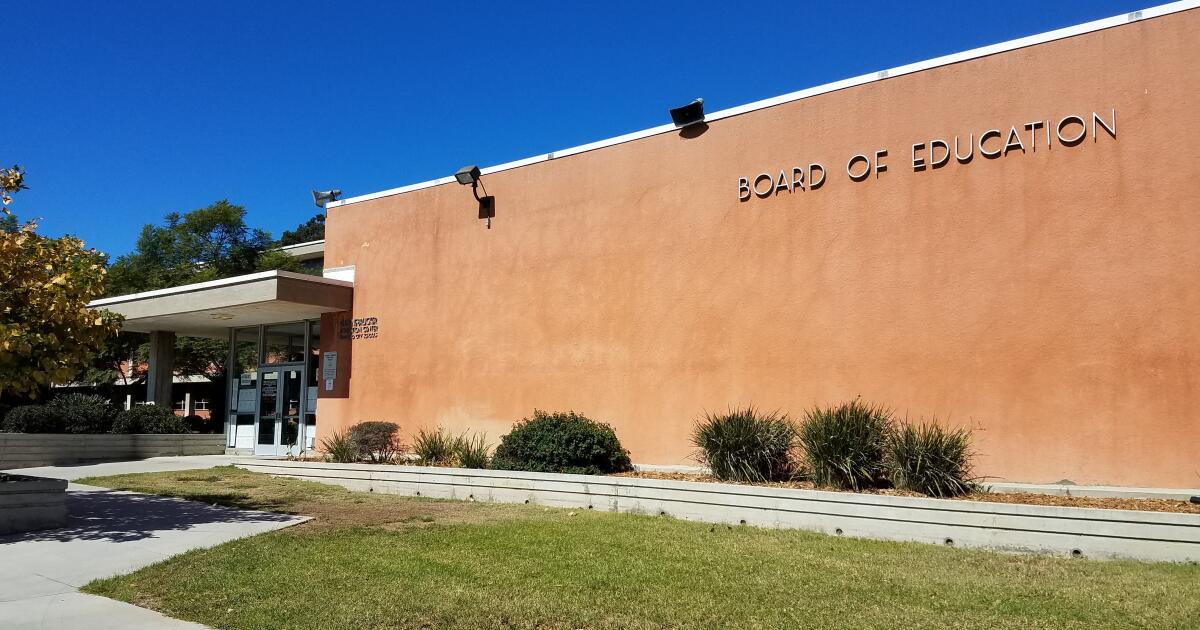
In the months since they were called back into district offices three years after going remote, multiple San Diego Unified School District employees have leveled complaints with the state about what they say are unhealthy and unsafe working conditions at the district headquarters, the Eugene Brucker Education Center in University Heights.
Employees say the Education Center, which is 70 years old, lacks working air conditioning, smells of mildew and is infested with roaches and ants. The toilet stall walls and doors are so low that people can see over them, they say. And some employees said they had to go to urgent care one day after they were exposed to a pesticide that had been sprayed in the office.
Those problems have fueled some district employees’ calls for a hybrid work option that would let them work from home part-time — an option that district leaders were making plans to offer, before they changed course.
Hundreds of San Diego Unified employees work in the district’s central office, in areas ranging from enrollment to contracting to human resources. Such a hybrid option would allow employees who work for the district office and do not regularly work at schools or with students to work remotely three days a week.
When the pandemic hit, district employees were sent home to work remotely. The district office’s remote work “pilot” technically ended in July 2022, according to the district, but employees weren’t required to return to the office until this August.
District leaders had written a draft policy to make hybrid work a permanent option and asked employees in September 2022 for input. Staff were told that the district was looking to implement the hybrid policy on Jan. 1, said Donis Coronel, executive director of the union that represents district administrators. Her union supported the policy and was one of two bargaining units with members who would have been eligible.
Employees said they heard nothing more until July, when members of the superintendent’s cabinet told them they had to return to in-person work by Aug. 16. Employees objected, and 276 staff members signed a letter urging the district to honor its prior plans for hybrid work, saying remote work benefits employee well-being and the environment.
“They made some missteps along the road,” Coronel said of district leaders. “Putting out a draft, then not moving forward with it, created a false sense that there was going to be a program, and there isn’t.”
In response, Chief Business Officer Drew Rowlands told staff in a September letter that a hybrid schedule was “not possible,” blaming remote work for “a lack of team cohesion, silos, and a disconnect among staff.”
But several employees said remote work had improved morale, saved transportation time and emissions and did not hurt the quality of their work.
As they returned to in-person work in August, at least two Education Center employees submitted complaints to the state Division of Occupational Safety and Health, known as Cal/OSHA, about the toilet stalls, lack of air conditioning and roaches.
This month, half a dozen employees spoke at a school board meeting to urge district leaders to adopt a hybrid work policy.
“We proved the success of telework,” said Carmen Peralta, a contract specialist for the district. “Keep your commitment not only to us but to your environment by implementing your telework policy.”
“I went from working in a quiet, clean, air-conditioned home office to working in an unsafe and unhealthy work environment at the Ed Center,” Marisa Berumen, who works in the district’s communications office, said at the same meeting.
In response to the complaints, San Diego Unified’s safety coordinator, Lori Sherman, told Cal/OSHA there was no problem with issues alleged. She said that the bathroom stall dividers and doors are 5 feet tall and “provide sufficient privacy.”
She said the district did not find a roach issue, pest control staff were working to address concerns, and employees have been asked not to keep food at their workspace to avoid attracting vermin.
And regarding air conditioning, Sherman noted five air-conditioned “cool zone” rooms that staff can use on hot days. However, employees have said the rooms are not always available, forcing them to move their computer equipment and rotate between available spaces.
Longtime school board Trustee Richard Barrera acknowledged the Education Center “is an awful place to work.”
“It’s been in terrible condition for a number of years,” Barrera said.
The only funding the district could use to replace the headquarters is voter-approved bond money, Barrera said. But he said district leaders had for years avoided including the Education Center in bond measures, because voters might be less likely to support projects to benefit district administration than for schools.
It wasn’t until 2018 that the district first included plans for a new headquarters in a bond measure, which won voter approval, Barrera said. The following year, the district used bond money to purchase an 8-acre site in Kearny Mesa for a new headquarters.
Employees from the Education Center, as well as its administration centers in Old Town and Linda Vista, will eventually move to the Kearny Mesa site. However, the new headquarters there isn’t expected to be completed for at least another three years.





